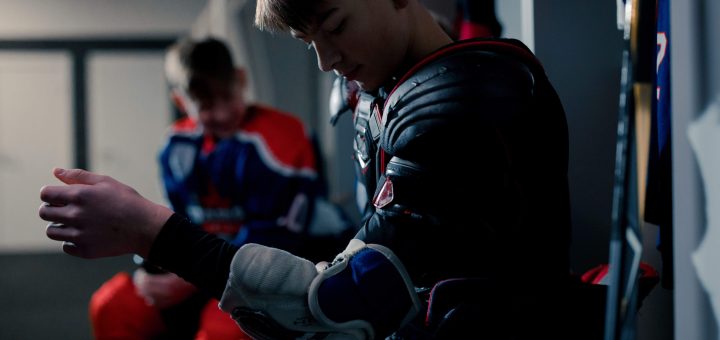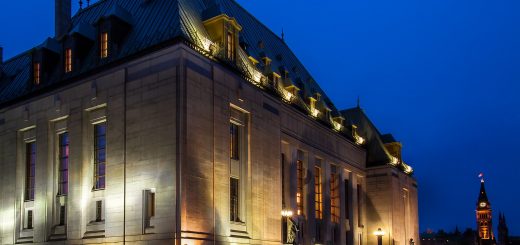Inherently Safe Places: Making Room for Sexual Integrity in R v Downes

In R v Downes, 2023 SCC 6 [Downes], the Supreme Court of Canada (the “SCC”, or the “Court”) clarified the nature and scope of voyeurism under s. 162(1) of the Criminal Code, RSC 1985, c C-46 [Criminal Code]. This marks the SCC’s first treatment of voyeurism since their landmark decision in R v Jarvis, 2019 SCC 10 [Jarvis], and expands on the interpretive foundation set out in that case.
The accused, Randy William Downes, was a youth hockey coach who operated a sports photography business out of his home (Downes, para 6). He was stopped by border officers upon returning home from the United States; upon searching his phone, the officers discovered a plethora of photos depicting children involved in sports activities, including some taken in locker rooms (Downes, para 7). Canada Border Services Agency officers alerted the RCMP, who subsequently obtained and executed a search warrant for Mr. Downes’ home and electronic devices (Downes, para 8).
Among the thousands of photos discovered by the RCMP on Mr. Downes’ devices, several focused specifically on two young boys aged 12-14 in various stages of undress. Many of these photos had been taken in a locker room. While none of the photos contained full nudity, some of the images depicted the young boys with their torso exposed or in their underwear. At no point were the children aware that they were being recorded. In the course of the investigation, Downes admitted to the RCMP that he had an affinity for young boys but denied that it was linked to any sexual motivation (Downes, para 8).
The accused was charged with two counts of voyeurism under s. 162(1)(a) of the Criminal Code. Section 162(1) provides:
Every one commits an offence who, surreptitiously, observes — including by mechanical or electronic means — or makes a visual recording of a person who is in circumstances that give rise to a reasonable expectation of privacy, if
(a) the person is in a place in which a person can reasonably be expected to be nude, to expose his or her genital organs or anal region or her breasts, or to be engaged in explicit sexual activity;
(b) the person is nude, is exposing his or her genital organs or anal region or her breasts, or is engaged in explicit sexual activity, and the observation or recording is done for the purpose of observing or recording a person in such a state or engaged in such an activity; or
(c) the observation or recording is done for a sexual purpose.
Supreme Court of British Columbia
Downes was subsequently convicted on both charges at trial. The trial judge determined that Downes had taken the photos intentionally, surreptitiously and, applying the factors identified by the Court in Jarvis, in circumstances where the young boys had a reasonable expectation of privacy. The trial judge further concluded that Downes had taken the photos in a location where a person may reasonably be expected to be nude, holding that it is common for individuals of all ages to change their underwear or shower in dressing rooms.
In reaching this conclusion, the trial judge expressly rejected Downes’ argument that the Crown was required to prove that the young boys specifically were reasonably expected to be nude in the dressing rooms. Rather, the trial judge held that s. 162(1)(a) focuses on only the nature of the place in which a recording is made. Notably, Downes did not take the position at trial that s. 162(1)(a) contains an implicit temporal component.
Court of Appeal for British Columbia
Downes appealed to the Court of Appeal for British Columbia (the “BCCA”) where a 2-1 majority set aside his convictions and ordered a new trial (“Downes BCCA”). The majority ruled that the trial judge had erred in failing to consider whether nudity was reasonably expected at the specific time the photos were taken, holding that s. 162(1)(a) could not be interpreted as criminalizing an invasion of privacy alone. The majority concluded that such a temporal requirement was necessary to fulfill Parliament’s objectives in enacting s. 162(1).
Dickson J.A. dissented, holding that s. 162(1)(a) contains no such implicit temporal component. Rather, in her view, s. 162(1)(a) is “categorical” in that it identifies a class of places where a person may reasonably be expected to be nude, exposing intimate body parts or engaging in sexual activity (Downes BCCA, para 78). Thus, the protection afforded by s. 162(1)(a) applies irrespective of the anticipated use of such a place at the time a recording is made, reflecting Parliament’s intention to criminalize the surreptitious recording of individuals in manifestly private places.
A ‘Big Picture’ Look at Voyeurism
In Downes, the Court was primarily tasked with answering a single question of law. Nevertheless, the SCC seized the opportunity to provide a more detailed picture of s. 162(1), carefully differentiating the three subsections from one another. Writing for a unanimous bench, Jamal J. reiterated that Parliament’s objective in enacting s. 162(1) was to protect both individuals’ privacy and sexual integrity in the face of threats of abuse posed by evolving technologies (Downes, para 28).
The sexual integrity objective is achieved differently under each subsection. Drawing upon the analysis of Juriansz J.A. in R v Trinchi, 2019 ONCA 356, Jamal J. articulated a conceptual approach wherein s. 162(1)(a) protects the sexual integrity of persons in specific places. Section 162(1)(b) protects the sexual integrity of persons engaged in specific activities, while s. 162(1)(c) provides protection where the observation or recording is made for a specific purpose—a sexual one (Downes, paras 31-34). Each subsection does not capture activity that is covered by another.
To illustrate, under s. 162(1)(b) the location of the recording and the purpose behind it become irrelevant because the analysis is concerned with safeguarding intimate activities. Plainly, an individual’s sexual integrity can be violated even where the accused made the recording for profit or blackmail, or in an otherwise public location (Downes, paras 32-33; Jarvis, paras 32, 143). Further, Jarvis had recognized that a loss of control over one’s own image for the sexual gratification of another strikes directly at one’s sexual integrity, no matter where it takes place nor the activities the victim was engaged in (Downes, para 34; Jarvis, paras 47, 52).
Downes’ objections that he did not take the photos for a sexual purpose and that the subjects of the photos were not nude were therefore entirely beside the point. The forms of sexual integrity engaged by those situations are not the focus of s. 162(1)(a)—they are plainly addressed by the latter two subsections. This would provide the backdrop for a more extensive discussion of the specific manner in which s. 162(1)(a) protects sexual integrity.
Mapping Out “Inherently Safe Places”
The central issue on appeal was whether s. 162(1)(a) contains a temporal element which restricts the offence to surreptitious recordings made when nudity can be reasonably expected in a given place (Downes, para 37). At a glance, the text of s. 162(1)(a) conspicuously lacks any express requirement that nudity be reasonably expected at the time of the recording. As Jamal J. points out, if Parliament had intended for the evaluation to be made at the time of the recording, it would have been easy for Parliament to indicate this outright, as they did in a neighbouring provision of the Criminal Code, s. 162.1. (Downes, para 42)
Beyond the words of the subsection, however, the prospect of interpreting s. 162(1)(a) without a temporal component could seem to pose a problem in light of Parliament’s goals and the broader context of s. 162(1). It may be difficult to understand how s. 162(1)(a) protects sexual integrity when it does not require a sexual motive on the part of the accused, nor even the prospect of nudity at the time of recording. This issue was already latent in Jarvis, where Wagner C.J. identified ss. 162(1)(b)-(c) as “the paragraphs that are most explicitly concerned with behaviours that impact on sexual integrity.” (Jarvis, para 52).
Against this backdrop, Jamal J. embraced the task of excavating the protective purpose behind s. 162(1)(a) and reiterating the broader conception of sexual integrity endorsed in the Court’s recent jurisprudence. This approach recognizes that sexual integrity is not simply concerned with physical harm or deprivations of bodily integrity. Rather, taking surreptitious photos in spaces where nudity is expected can have severe emotional and psychological impacts for the victims, even when they are not nude. These impacts are particularly salient for children, and can reverberate throughout their development. As Jamal J. points out:
Such photos can injure a person’s sexual integrity by reducing (the subjects) to body parts, by hindering them from developing their sexuality as they see fit, and by creating a risk of widespread dissemination of the photos to strangers. (Downes, para 53)
This conceptual approach highlights the inextricable link between sexual integrity and privacy in the context of voyeurism, illustrating the perils of attempting to characterize any aspect of s. 162(1) as creating a pure privacy offence. Rather, s. 162(1)(a) is primarily concerned with punishing an accused who runs the risk of inflicting significant emotional and psychological harm on their subjects, which may include inhibiting those subjects from developing a sense of security in the more intimate aspects of their own body. This is not the same as punishing the bare fact of intrusion on a reasonable expectation of privacy.
With this in mind, protecting sexual integrity means providing an enduring protection to those locations where Parliament has determined that one should be free from non-consensual observation or recording. As Dickson J.A. stated in her dissent at the BCCA, this approach is “categorical”—it denotes a class of locations where a person can reasonably be expected to be nude, intimately exposed, or engaged in sexual activity (Downes BCCA, para 78). These locations are “inherently safe places”, and include all of the quasi-private and private spaces identified in Jarvis – homes, bathrooms, dressing rooms and their variants (Downes, paras 45, 53; Jarvis, para 46). The normative, open-ended nature of this class of locations leaves open the possibility that the list of inherently safe places will expand in the future, in line with Parliament’s goals of providing flexibility to combat emergent technological threats to privacy and sexual integrity.
The Upside of Downes
The SCC’s decision in Downes builds on the foundation set in Jarvis, providing a more complete picture of voyeurism under the Criminal Code. While the principles in Jarvis were diffuse, Downes carefully details the structure of s. 162(1), articulating the scope of each subsection and their respective roles in protecting sexual integrity.
Further, Jamal J.’s retrenchment of the Court’s expanded conception of sexual integrity indirectly eliminates many residual questions surrounding voyeurism, including the constitutional argument raised by Mr. Downes that Parliament went further than necessary to protect sexual integrity. While the Court declined to consider this argument on procedural grounds (Downes, paras 55-58), the finding that s. 162(1)(a) is not a pure privacy offence deftly closes off any future prospect of success this argument may have had.
Downes is the SCC’s most comprehensive pronouncement on voyeurism to date, neatly tying together many of the threads that remained post-Jarvis. Jamal J.’s robust and expansive analysis signals that the Court is unlikely to address s. 162(1) of the Criminal Code again in the near future—unless it is to stake out further territory for inherently safe places.
Editor: Farah Abdel Haleem







Join the conversation